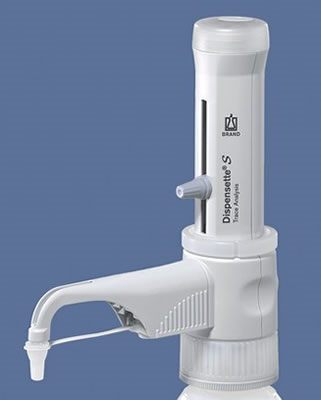BRAND Dispensette S Trace Analysis Bottletop Dispensers
from BrandTech Scientific, Inc.
 4640040 4640041 4640240 4640241
4640040 4640041 4640240 4640241
For dispensing high-purity chemicals.
- The Dispensette S Trace Analysis provides outstanding performance for precise-volume dispensing of high-purity media for trace analysis.
- - The Dispensette S Trace Analysis is also suitable for dispensing HF (Pt-Ir model).
- - The components of the fluid path have been selected to only contain the highest purity materials, such as fluoroplastics and sapphire.
- - Depending on application, either platinum-iridium (Pt-Ir) or tantalum (Ta) valve springs can be chosen.
- - The volume range is from 1 to 10mL.
- Especially well-suited for dispensing acids, bases and hydrogen peroxide (Tantalum (Ta) models only).
- Trace metal content of dispensed liquid is generally in the low ppb range or, depending on application, even in the low ppt range.
Dispensing of high-purity chemicals in trace analysis.
- Plastics in contact with media consist of high-purity materials such as PTFE, ETFE, PCTFE, FEP and PFA.
- - The purest sapphire is used for replaceable valves.
- - Depending on the application, platinum-iridium or tantalum are available as spring materials.
- A field-tested cleaning process before use in trace analysis is described in the operating manual.
- Easy to disassemble for replacement of the dispensing cartridge.
- The high-purity materials release virtually no metal ions after appropriate cleaning.
- - This makes the Dispensette S Trace Analysis bottletop dispenser a superior choice for trace analysis.
Replaceable dispensing cartridge.
- If the piston seal is worn after a long period of use, the entire dispensing cartridge can easily be replaced without tools by the user.
- The cartridge is fully adjusted at the factory and delivered with a performance certificate.
- - No calibration is required after replacement.
Serial dispensing.
- For easy serial dispensing, an optional flexible discharge tube with textured safety handle (not approved for HF) permits fast and precise dispensing, even into narrow test tubes.
- - Integrated recirculation valve helps purge bubbles before dispensing.
Operating limitations (all instruments).
- Liquids which form deposits may make the piston difficult to move or may cause jamming (e.g., crystallizing solutions or concentrated alkaline solutions).
- When dispensing inflammable media, make sure to avoid the buildup of static charge, (e.g., do not dispense into plastic vessels; do not wipe instruments with a dry cloth).
- The Dispensette is designed for general laboratory applications and complies with the relevant standards, e.g., DIN EN ISO 8655. Compatibility of the instrument for a specific application (e.g., trace material analysis, food sector, etc.) must be checked by the user.
- - Approvals for specific applications, (e.g., for production and administration of food, pharmaceuticals and cosmetics) are not available.
Limitations of use.
- This instrument is designed for dispensing liquids, observing the following physical limits:
- - Use between +15°C and +40°C (59°F and 104°F) of instrument and reagent.
- - Vapor pressure up to max. 600mbar. Aspirate slowly above 300mbar, in order to prevent the liquid from boiling.
- - Kinematic viscosity up to 500mm2/s (dynamic viscosity [mPas] = kinematic viscosity [mm2/s] x density [g/cm3]).
- - Density: Dispensette S Trace Analysis up to 3.8g/cm3.
Items supplied Dispensette S Trace Analysis includes:
- Certificate of performance.
- Discharge tube.
- Valve mounting/calibration tool.
- Adapters and filling tube.
- Operating manual.
- One-year warranty.
Operating exclusions - Dispensette S Trace Analysis.
- Never use the Dispensette S Trace Analysis with:
- - Liquids attacking Al2O3 sapphire or fluoroplastics like ETFE, FEP, PFA, PCTFE, PTFA and PTFE (e.g., dissolved sodium azide*).
- - Liquids which are decomposed catalytically by platinum-iridium (e.g., H2O2) or tantalum, depending on the construction of the instrument.
- - Organic solvents.
- - Trifluoroacetic acid.
- - Explosive liquids (e.g., carbon disulfide).
- - Suspensions (e.g., of charcoal) as solid particles may clog or damage the instrument.
- - The Dispensette S Trace Analysis must not be autoclaved.
